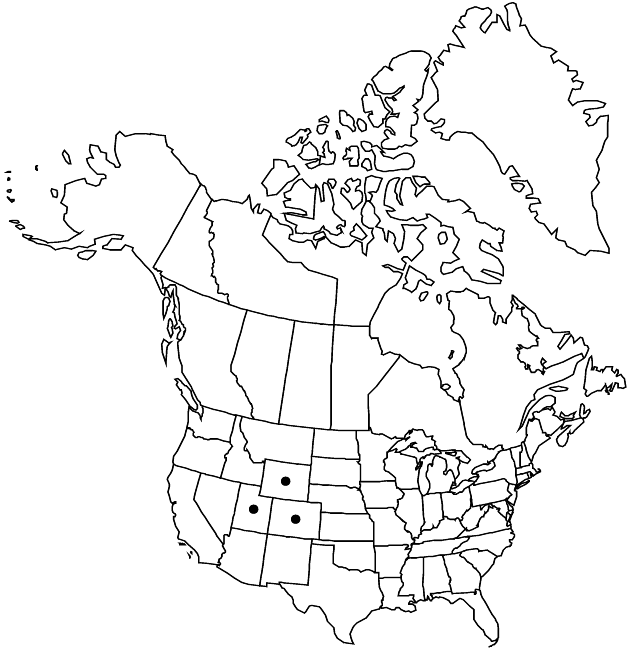Difference between revisions of "Cirsium ownbeyi"
Great Basin Naturalist 42: 200. 1982.
FNA>Volume Importer |
FNA>Volume Importer |
||
| Line 24: | Line 24: | ||
|elevation=1500–2400 m | |elevation=1500–2400 m | ||
|distribution=Colo.;Utah;Wyo. | |distribution=Colo.;Utah;Wyo. | ||
| − | |discussion=<p>Cirsium ownbeyi is endemic to the eastern side of the Uintah Mountains in northeastern Utah, southwestern Wyoming, and northwestern Colorado. It is in the Center for Plant Conservation’s National Collection of Endangered Plants.</p> | + | |discussion=<p><i>Cirsium ownbeyi</i> is endemic to the eastern side of the Uintah Mountains in northeastern Utah, southwestern Wyoming, and northwestern Colorado. It is in the Center for Plant Conservation’s National Collection of Endangered Plants.</p> |
|tables= | |tables= | ||
|references= | |references= | ||
| Line 48: | Line 48: | ||
|publication year=1982 | |publication year=1982 | ||
|special status= | |special status= | ||
| − | |source xml=https://jpend@bitbucket.org/aafc-mbb/fna-data-curation.git/src/ | + | |source xml=https://jpend@bitbucket.org/aafc-mbb/fna-data-curation.git/src/8f726806613d60c220dc4493de13607dd3150896/coarse_grained_fna_xml/V19-20-21/V19_148.xml |
|tribe=Asteraceae tribe Cardueae | |tribe=Asteraceae tribe Cardueae | ||
|genus=Cirsium | |genus=Cirsium | ||
Revision as of 15:09, 18 September 2019
Perennials, 30–70 cm; taproots and branched caudices with persistent dark-brown leaf bases. Stems 1–several, erect, simple or sparingly branched in distal 1/2, glabrous or thinly arachnoid and sparingly villous with jointed trichomes. Leaves: blades oblong to elliptic or oblanceolate, 15–30+ × 2–7 cm, deeply 2–3-pinnately divided, lobes linear to linear-lanceolate, spinulose to spiny-dentate or shallowly lobed, main spines slender, 2–8 mm, abaxial faces glabrous to thinly tomentose and villous along major veins, soon glabrescent, adaxial glabrous; basal present at flowering, narrowly spiny winged-petiolate; principal cauline well distributed, proximal winged-petiolate, mid and distal sessile, gradually reduced, bases decurrent as spiny wings 1–3 cm; distalmost reduced to spiny-pectinate bracts. Heads 1–few, erect, ± crowded in corymbiform arrays. Peduncles 0–4 cm. Involucres ovoid, 1.8–2.5 cm, 1.5–2.5 cm diam., loosely arachnoid, glabrate. Phyllaries in 5–6 series, imbricate, green, linear-lanceolate, abaxial faces without or with poorly developed glutinous ridge; outer and mid bases appressed, apices stiffly radiating to ascending, long, very narrow, entire, spines slender, 3–10 mm; apices of inner straight, flexuous. Corollas white to pink or pink-purple, 16–20 mm, tubes 6–8 mm, throats 5–6 mm, lobes 5–7 mm; style tips 3.5–4.5 mm. Cypselae brown, ca. 4 mm, apical collars not differentiated; pappi 13–17 mm.
Phenology: Flowering summer (Jun–Aug).
Habitat: Stony soils in sparsely vegetated areas of pinyon-juniper woodlands, sagebrush scrub, arid grasslands, and riparian scrub, in dry sites or sometimes on seeps
Elevation: 1500–2400 m
Distribution

Colo., Utah, Wyo.
Discussion
Cirsium ownbeyi is endemic to the eastern side of the Uintah Mountains in northeastern Utah, southwestern Wyoming, and northwestern Colorado. It is in the Center for Plant Conservation’s National Collection of Endangered Plants.
Selected References
None.